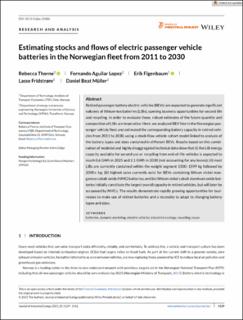| dc.contributor.author | Thorne, Rebecca | |
| dc.contributor.author | Aguilar Lopez, Fernando | |
| dc.contributor.author | Figenbaum, Erik | |
| dc.contributor.author | Fridstrøm, Lasse | |
| dc.contributor.author | Mueller, Daniel Beat | |
| dc.date.accessioned | 2022-03-02T09:21:18Z | |
| dc.date.available | 2022-03-02T09:21:18Z | |
| dc.date.created | 2021-09-03T15:35:12Z | |
| dc.date.issued | 2021 | |
| dc.identifier.citation | Journal of Industrial Ecology. 2021, 25 (6), 1529-1542. | en_US |
| dc.identifier.issn | 1088-1980 | |
| dc.identifier.uri | https://hdl.handle.net/11250/2982339 | |
| dc.description.abstract | Retired passenger battery electric vehicles (BEVs) are expected to generate significant volumes of lithium-ion batteries (LIBs), opening business opportunities for second life and recycling. In order to evaluate these, robust estimates of the future quantity and composition of LIBs are imperative. Here, we analyzed BEV fate in the Norwegian passenger vehicle fleet and estimated the corresponding battery capacity in retired vehicles from 2011 to 2030, using a stock-flow vehicle cohort model linked to analysis of the battery types and sizes contained in different BEVs. Results based on this combination of modeled and highly disaggregated technical data show that (i) the LIB energy capacity available for second use or recycling from end-of-life vehicles is expected to reach 0.6 GWh in 2025 and 2.1 GWh in 2030 (not accounting for any losses); (ii) most LIBs are currently contained within the weight segment 1500–1599 kg followed by 2000+ kg; (iii) highest sales currently exist for BEVs containing lithium nickel manganese cobalt oxide (NMC) batteries; and (iv) lithium nickel cobalt aluminum oxide batteries initially constitute the largest overall capacity in retired vehicles, but will later be surpassed by NMCs. The results demonstrate rapidly growing opportunities for businesses to make use of retired batteries and a necessity to adapt to changing battery types and sizes. | en_US |
| dc.language.iso | eng | en_US |
| dc.publisher | Wiley | en_US |
| dc.rights | Navngivelse 4.0 Internasjonal | * |
| dc.rights.uri | http://creativecommons.org/licenses/by/4.0/deed.no | * |
| dc.title | Estimating stocks and flows of electric passenger vehicle batteries in the Norwegian fleet from 2011 to 2030 | en_US |
| dc.type | Journal article | en_US |
| dc.type | Peer reviewed | en_US |
| dc.description.version | publishedVersion | en_US |
| dc.source.pagenumber | 1529-1542 | en_US |
| dc.source.volume | 25 | en_US |
| dc.source.journal | Journal of Industrial Ecology | en_US |
| dc.source.issue | 6 | en_US |
| dc.identifier.doi | 10.1111/jiec.13186 | |
| dc.identifier.cristin | 1931225 | |
| dc.relation.project | Norges forskningsråd: 299334 | en_US |
| cristin.ispublished | true | |
| cristin.fulltext | original | |
| cristin.qualitycode | 2 | |

